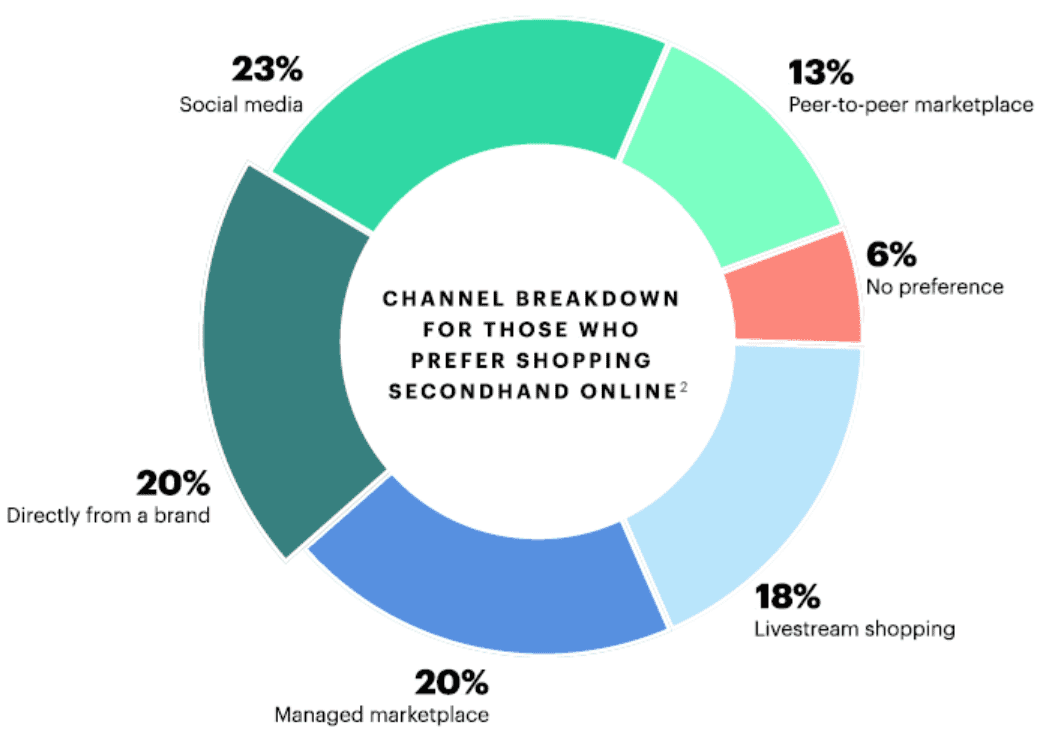A few years ago, buying resale online was still something that had to be sold to consumers. But as ThredUp’s 12th annual Resale Report shows, the need for a hard sell is over — consumers of all ages have clearly bought into the idea, with secondhand apparel sales growing 15X faster than the broader retail clothing sector in 2023.

In 2023, global sales of secondhand apparel reached a staggering $197 billion (up 18% from $167 billion the year before), and ThredUp projects that figure will reach $350 billion by 2028. In the U.S. alone, secondhand apparel accounted for $43 billion in sales in 2023, and it’s expected to reach $73 billion by 2028.
“With more than half of all consumers shopping for secondhand apparel last year, it’s evident that resale is now firmly embedded in the fashion landscape,” said Neil Saunders, Managing Director at GlobalData, which conducted the research for the report, in a statement.
Now the question is: Where does resale go from here? James Reinhart, CEO of ThredUp, sees ample white space ahead both for his own company and the larger industry.
Advertisement
1. Getting More Consumers to Think ‘Secondhand First’
“If you were to survey 100 Americans about their secondhand purchasing behavior, you would definitely find a group of hardcore resale shoppers where 70% to 80% of their closet is resale, but that heavy-use group is still a small portion,” said Reinhart in an interview with Retail TouchPoints. “I think the next area of significant closet-share penetration will come from casual shoppers. I still don’t think we’ve hit the point where [a whole] generation is thinking secondhand first. We’re still in more of an ‘I dabble in secondhand’ moment, so over the next few years changing those behaviors could be a real catalyst for momentum.”

And as Reinhart pointed out, once a consumer discovers the benefits of secondhand shopping, it tends to become an ingrained behavior: “The 20-somethings and early-30-somethings who are spending a ton on secondhand right now are just at the beginning of their purchasing power journey,” he said. “And it’s hard to believe that all of a sudden they’ll get to their late ’30s and decide, ‘Now it’s only new stuff for me.’”
In fact, ThredUp’s latest Resale Report found that secondhand buying appeals almost equally to all generations — albeit for different reasons. “Younger shoppers turn to secondhand for self-expression and to help create their personal style; parents rely on secondhand to outfit their families in a cost-effective and eco-conscious way; and older generations turn to secondhand to snag affordable, higher-end brands and for the thrill of the hunt,” explained GlobalData’s Saunders. “Secondhand’s flexibility in meeting such varied needs is a key reason it’s become so popular and has such a promising growth trajectory.”
Purchasing secondhand online also opens up this world to many new consumers who had found thrift stores unappealing or intimidating, and much of that tech is just at the beginning of its journey as well. “A lot of new tech starts out as more of a toy, but then it evolves to become more of a default consumer experience,” said Reinhart. “It’s similar with thrifting, where it starts out just as something that’s fun and then eventually you hit this penetration curve where it becomes more of a default experience. That’s where the next [wave of growth will come].”
2. Growing Share of Closet
Technological enhancements also are making online resale tools more efficient and effective at meeting shoppers’ needs, further driving usage. ThredUp, for example, recently rolled out a new AI-powered search that Reinhart said is “100 times better than what we had before” at helping users find the kind of items they’re looking for — a particularly challenging task for a website that carries 4 million unique items.

And ThredUp isn’t alone in working to enhance the CX of online resale: Newegg and Ebay both have rolled out authenticity programs to give online shoppers more confidence in their purchases; GoodwillFinds added returns capabilities; Mercari launched a ChatGPT-powered shopping assistant; and Thriftbooks leverages a range of automation technologies to drive operational efficiencies that allow it to keep prices low.
In fact, the ThredUp report found that for the first time ever, younger generations now prefer buying online versus in stores: 45% of Gen Z and millennials said they prefer to buy secondhand apparel online, compared to 38% who prefer to buy in a store. And nearly two in every three consumers who made a secondhand apparel purchase in 2023 made at least one of those purchases online, an increase of 17 percentage points from 2022.
“I think what’s also happening is the share of the closet that’s secondhand is accelerating,” said Reinhart. “That can be fed by stores and online but overall, the number of resale items that are being purchased is growing. I also think the velocity with which [people are buying] stuff and reselling other things is increasing. That velocity of secondhand in the closet versus total items is hard to capture, because velocity can be accelerating, but [that] doesn’t mean our closets are getting bigger; it just means we’re cycling through items faster.”
3. Codifying Circularity
In recent months the resale industry also has gotten a big boost from governments, with both America and France moving forward with legislation that promotes circular practices. The Americas Trade and Investment Act (Americas Act for short) is designed to promote economic potential in the U.S. and Latin America by encouraging reshoring and nearshoring, and it includes over $14 billion in incentives to “catalyze domestic circularity” in the apparel, footwear and accessories industries. And a bill in France that would impose levies on fast fashion companies and restrict their advertising opportunities is making its way through that country’s parliament.
For the first time, ThredUp included research on the government’s role in promoting sustainability in its report, and the findings are unequivocal:
- 42% of consumers said the government should take legislative action to help promote sustainable fashion;
- 40% of consumers said they’re more likely to vote for a candidate that supports sustainable fashion;
- 52% of retail executives said they’d adopt circular business models if there were government-sponsored financial incentives for doing so; and
- 65% of consumers said sales tax should be eliminated on secondhand apparel, with 50% saying they’d buy more secondhand if there were no sales tax.
“A couple of years ago there wasn’t a huge appetite for this kind of thing,” said Christina Berger, Senior Director of Corporate Communications, ESG and Policy at ThredUp in an interview with Retail TouchPoints. “But in the last six to 12 months we’re getting more and more inbound requests from legislative offices and the like that want to learn more and be educated on the topic.”
“It’s hard to get anything done in Congress, especially right now, but I think this is actually an issue that Democrats and Republicans can agree on,” added Reinhart. “And it’s a good narrative going into an election year — protecting jobs, reshoring — it’s one way where you can be pro-environment without being anti-business.”
4. Proving that Resale can be Profitable
With the ecommerce boom days of the pandemic well behind us, the heat is on public companies operating in resale, like ThredUp, to not just make headlines but actual profits. Reinhart has been open about the challenges of doing this while also committing to improving the company’s financials.
In Q3 2023 (reported on Nov. 6, 2023), ThredUp reached U.S. quarterly adjusted EBITDA breakeven for the first time in company history, and for “seven of the last eight quarters EBITDA has improved every quarter; you don’t need to be a math major to understand that trendline,” said Reinhart. “The trajectory for us is pretty clear: we just need to continue to focus on steady progress.”
Last year, ThredUp zeroed in on its unit economics, testing out new fees and policies to make the business more financially efficient. That work will continue this year, and Reinhart said he’s also interested to see how the AI solutions the company is working with will impact both the top and bottom line, noting that it is possible that “we’ll need fewer people doing certain functions.”

The company’s resale-as-a-service (RaaS) business, which operates white label resale programs for dozens of retailers, also is booming, offering brands a low-lift opportunity to enter resale. And more and more brands are looking to do just that, with the ThredUp report indicating that as many as 163 brands now offer their own resale shops (not necessarily through ThredUp), which is a 31% increase from 2022.
But while RaaS is another revenue stream for ThredUp, Reinhart said the growth driver for the business remains its core resale marketplace. Still, “RaaS is really important,” he added. “The thing that I think is underappreciated about RaaS is how powerful that is for the ThredUp brand. Over 800 stores now have a ThredUp co-branded cleanout kit in them. There’s a lot of value in that.”
All in all, Reinhart said he feels “supremely confident” about the future of both ThredUp and resale as a whole. “The Resale Report shows that this is a huge industry, and it’s only getting bigger,” he said. “Young people are going to shop more thrift in the future, and we’re committed to it. We deserve to exist. There are a lot of businesses out there that I don’t know what their reason is to exist. To sell more s**t? No, that’s not a good reason to exist. We’re just staying focused on our long-term mission and being consistent in our approach.”









